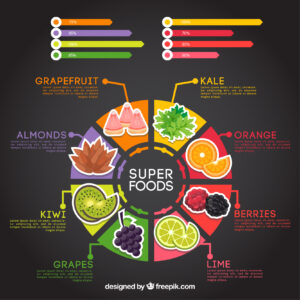Upgrade Your Meals: Top Nutrient Hacks to Supercharge Your Health
We all know the importance of eating healthy. But sometimes, even the most well-intentioned meals can fall short in the nutritional department. This is where top nutrient hacks come in! These simple strategies can unlock the hidden nutritional power of your meals, ensuring you get the essential vitamins, minerals, and other beneficial compounds your body needs to thrive.
Why Nutrient Hacks Matter
A balanced diet rich in essential nutrients is the foundation of good health. Top nutrient hacks help you optimize your meals in several ways:

- Increased Nutrient Absorption: Certain foods enhance the absorption of nutrients from other foods. By incorporating these pairings into your meals, you ensure your body gets the most out of the food you consume.
- Enhanced Bioavailability: Bioavailability refers to the amount of a nutrient that your body can absorb and utilize. Top nutrient hacks can improve the bioavailability of certain nutrients, making them more readily available for your body’s processes.
- Boosted Flavor and Variety: Let’s face it, healthy eating can sometimes feel bland. Top nutrient hacks often involve adding flavorful ingredients or using cooking techniques that enhance the taste and enjoyment of your meals, making healthy eating more sustainable long-term.
- Reduced Anti-Nutrients: Certain foods contain anti-nutrients that can interfere with nutrient absorption. Top nutrient hacks can help mitigate the effects of anti-nutrients, ensuring you get the full benefit of the nutrients in your food.
Top Nutrient Hacks to Supercharge Your Meals
Here are some of the top nutrient hacks you can incorporate into your daily meals:

- Pair Iron with Vitamin C: Iron is an essential mineral for oxygen transport and energy production. However, its absorption can be hindered by certain compounds in plant-based foods. To optimize iron absorption, pair iron-rich foods like lentils, beans, or tofu with foods rich in vitamin C, like citrus fruits, bell peppers, or broccoli. Vitamin C helps convert iron into a more absorbable form.
- Enhance Calcium Absorption with Vitamin D: Calcium is crucial for strong bones and teeth. However, vitamin D is necessary for proper calcium absorption. Include a source of vitamin D in your meals with calcium-rich foods like dairy products, leafy greens, or fortified tofu. Fatty fish, eggs, and mushrooms are good natural sources of vitamin D.
- Unleash the Power of Fat-Soluble Vitamins: Vitamins A, D, E, and K are fat-soluble, meaning they require fat for proper absorption. Include a healthy fat source like olive oil, avocado, nuts, or seeds with meals rich in these vitamins. For example, drizzle olive oil over your carrots (vitamin A) or enjoy a side of avocado with your salmon (vitamin D).
- Soak and Sprout Beans and Legumes: Beans and legumes are excellent sources of protein and fiber. However, they also contain anti-nutrients called lectins that can hinder nutrient absorption and cause digestive discomfort. Soaking and sprouting beans and legumes can significantly reduce lectin content, making them more digestible and enhancing nutrient bioavailability.
- Ferment for Enhanced Gut Health and Nutrient Absorption: Fermented foods like yogurt, kimchi, sauerkraut, and kombucha are teeming with beneficial live bacteria (probiotics). These probiotics promote gut health, which plays a crucial role in nutrient absorption. Incorporating fermented foods into your diet can improve the absorption of various nutrients, including iron, calcium, and zinc.
- Embrace Colorful Variety: Fruits and vegetables come in a vibrant array of colors, each boasting a unique set of phytonutrients. These plant compounds offer numerous health benefits. By including a variety of colorful fruits and vegetables in your diet, you ensure you’re getting a broad spectrum of these beneficial phytonutrients.
- Spice Up Your Life: Certain spices like turmeric, ginger, and black pepper offer potent anti-inflammatory and antioxidant properties. Adding these spices to your meals not only enhances flavor but also boosts the overall nutrient profile.
- Cook with Cast Iron Skillets: Cast iron skillets not only offer even heat distribution but also naturally leach small amounts of iron into your food. This can be beneficial for individuals prone to iron deficiency.
- Go Beyond Salting: Sodium is an essential mineral, but most people consume too much. Explore flavorful alternatives like herbs, spices, lemon juice, or vinegar to add zest to your meals while reducing your reliance on salt.
- Plan and Prep: Planning your meals and prepping ingredients in advance can help you make healthy choices throughout the week. With healthy options readily available, you’ll be less likely to resort to unhealthy convenience foods
Beyond the Hacks: Building a Nutrient-Rich Diet
Top nutrient hacks are a fantastic way to elevate the nutritional value of your meals. However, they shouldn’t be the sole focus of a healthy diet. Here are some additional strategies to build a well-rounded and nutrient-rich dietary foundation:
- Focus on Whole Foods: Prioritize whole, unprocessed foods like fruits, vegetables, whole grains, lean protein sources, and healthy fats. These foods are packed with essential nutrients, fiber, and beneficial compounds that support overall health.
- Limit Processed Foods: Processed foods are often loaded with unhealthy fats, added sugars, sodium, and artificial ingredients. Limit your intake of processed snacks, sugary drinks, and fast food.
- Read Food Labels: Becoming a savvy label reader empowers you to make informed choices. Pay attention to serving sizes, ingredient lists, and the nutrient content of the foods you consume.
- Variety is Key: Don’t get stuck in a rut! Explore different food groups and try new recipes to ensure you’re getting a broad spectrum of nutrients and keep your meals interesting.
- Cook More Meals at Home: Cooking at home allows you to control ingredients, portion sizes, and cooking methods. This gives you greater control over the nutritional quality of your meals.
- Stay Hydrated: Drinking plenty of water throughout the day is crucial for optimal health and nutrient absorption. Aim for eight glasses of water per day.
- Mindful Eating: Pay attention to hunger and fullness cues. Eat slowly and savor your food, stopping when you feel comfortably full.
- Manage Stress: Chronic stress can disrupt your appetite and hinder nutrient absorption. Find healthy ways to manage stress, such as exercise, yoga, or meditation.
Remember: Consistency is key! While top nutrient hacks offer valuable strategies, building a healthy diet is a long-term commitment. By incorporating these hacks and additional tips into your daily routine, you can create a sustainable approach to healthy eating that nourishes your body and optimizes your health.
Additional Resources:
- The United States Department of Agriculture (USDA): https://www.myplate.gov/
- The Academy of Nutrition and Dietetics: https://www.eatright.org/
- The World Health Organization (WHO): https://www.who.int/news-room/fact-sheets/detail/healthy-diet
By embracing a nutrient-rich diet and incorporating top nutrient hacks, you can unlock the full potential of the food you eat. Nourish your body with essential vitamins, minerals, and other beneficial compounds, and experience the vitality and well-being that comes with a healthy and balanced lifestyle. So, get creative in the kitchen, explore new flavors, and empower yourself to make healthy choices that fuel your body and mind!
Sources
info

